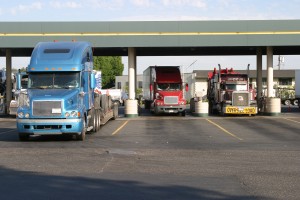A weigh station is a designated stop where the Department of Transportation (DOT) inspects the weight of a vehicle to ensure you are traveling with a safe load. Weigh stations are very important for all cars on the road, as overweight vehicles can cause major problems on a highway. In the U.S., the maximum weight of a truck with a full trailer is 80,000 pounds. For new truckers who have yet to encounter their first trip to a weigh station, here are a few things you should know.
Who Has To Stop
Any commercial motor vehicle weighing over 10,000 pounds is required to stop at a weigh station, with a few exceptions. For example, if the driver has a PrePass or a weigh station bypass service, they may not be required to stop. Apps like Trucker Path allow truck drivers to check ahead to make sure a weigh station is open or closed, saving them valuable time while on a long haul.
What Happens At A Weigh Station?
Along the highway, there are often green signs that say “weigh station” with a notice whether it is open or closed. If the station is open, the trucker must exit and enter the scales for the truck to be weighed. Many weigh stations have a rolling scales that allows a truck to roll past a certain area that has a scale. The truck must be verified to weigh under 80,000 pounds, and if it passes, it is cleared as safe to drive on the highway. However, the truck may be flagged for inspection by a DOT or state inspection officer for a variety of reasons.
DOT officers or Federal Motor Carrier Safety Administration agents may decide to conduct a thorough equipment safety inspection to find issues with a truck, including flat tires, oil or anti-freeze leaks, brake malfunctions, cracks in wheels and rims, and more.
Log Book Inspection
After the truck is weighed, your DOT number will be entered into a computer system for a log book inspection. This is to make sure that the driver is keeping a daily record of their driving hours, and isn’t in violation of hours-of-service laws. Truckers have strict rules about how many hours they can drive in a day and a week to ensure they are driving as safely as possible and getting the necessary rest and break time. DOT hours of service regulations include:
- Maximum of 11 hours of driving during a 14-hour period
- No more than 60 hours total in seven consecutive days on duty
- No more than 70 hours total in eight consecutive days on duty
- Required 10 consecutive hours off after 11 hours of driving
For All of Your Trucking Needs
Evan Transportation provides trucking and transportation services for clients throughout the Mid-Atlantic region. All of our drivers and staff are offered competitive salaries, benefits, and are guaranteed to be home every day. Interested in finding out more? Visit us online or give us a call at 443-673-3365. For even more information, visit us on Facebook, Twitter, Pinterest, LinkedIn, and Google+.
Tags: Evan Transportation, truck driving, trucking industry, trucking life, weigh stations

